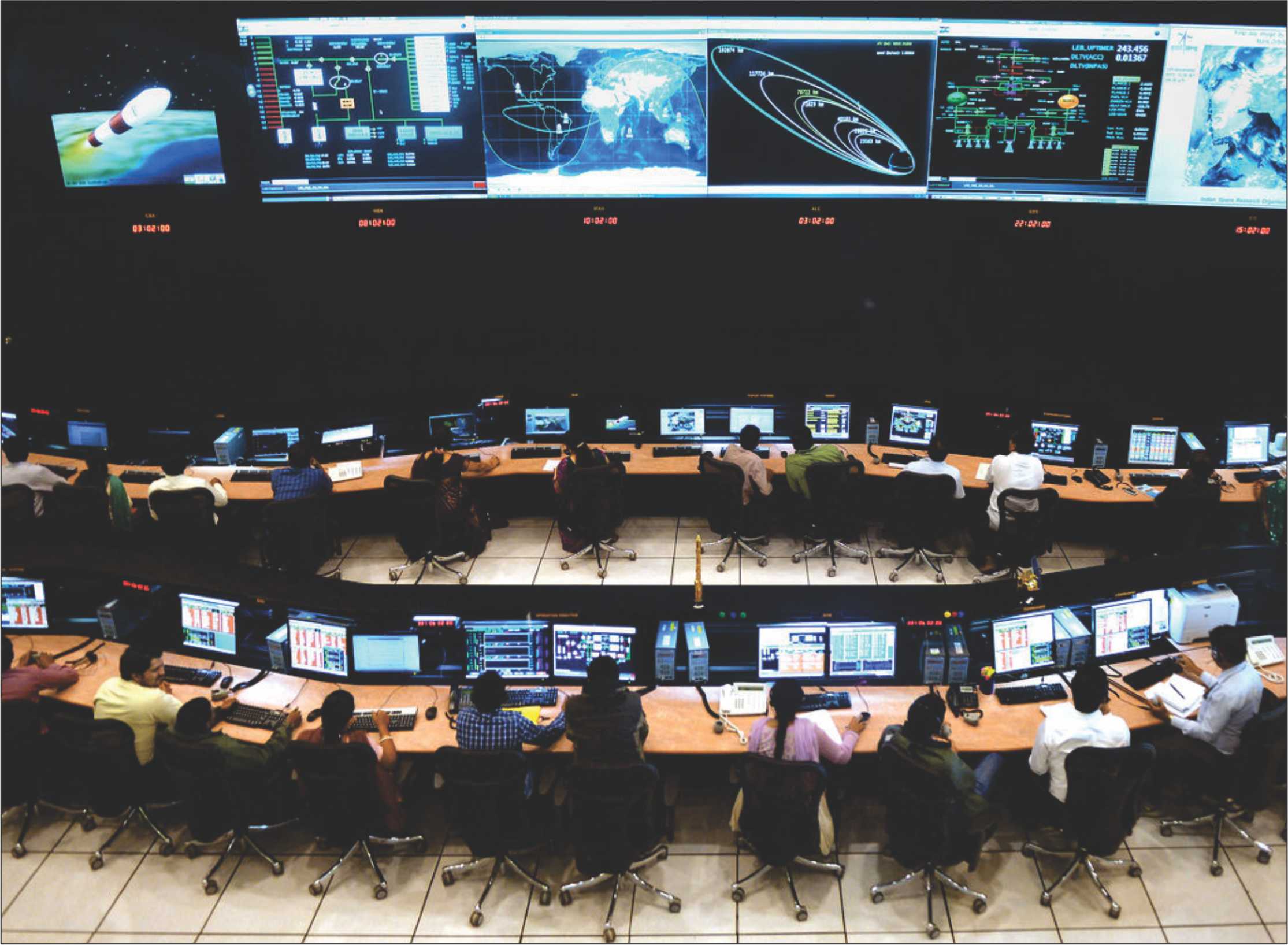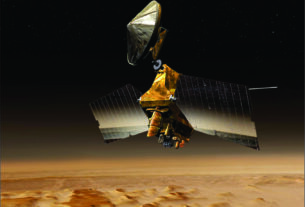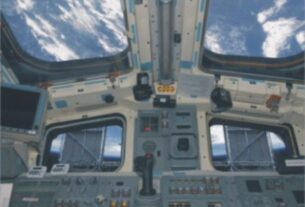The successful insertion of India’s first interplanetary probe, Mangalyaan Mars Orbiter Mission (MOM) into its final orbit around the Red Planet recently following a series of complex and challenging operations, has opened up a new, scintillating chapter in the exciting space history of India.
Verily, India has accomplished the distinction of becoming the first country in the world to reach Mars in the very first attempt. Russia, USA and European Space Agency (ESA), which have been successful in their mission of orbiting their spacecraft around or landing on Mars could achieve the distinction only after many failures and repeated attempts. More importantly, India has raced past China and Japan to reach the orbit around Mars and become the first Asian country to successfully pull off a mission to Mars.
Significantly, MOM Mangalyaan is considered the fastest and cheapest ever ticket to the Red Planet. It is not for nothing that the Indian Prime Minister Narendra Modi while addressing the reception organised in his honour by the Indian American Community Foundation at Madison Square Garden in New York cited the metaphor of cost of travel by a three wheeler in Ahmedabad and the expenditure incurred by MOM. “A one km auto rickshaw drive in Ahmedabad takes Rs.10 while India reached Red Planet at Rs.7 per km which is really amazing,”observed Modi.
Space program
However, on a down to earth plane, the unqualified success of Indian Mars probe Mangalyaan marks a giant leap for the Indian Space Research Organisation (ISRO) in terms of mastering the complex technologies involved in the accomplishment of a deep space planetary mission. Without doubt, the spectacular triumph of Mangalyaan has provided ISRO with an opportunity to acquire technological expertise in areas such as spacecraft autonomy, long distance space communications, inter-planetary navigation and miniaturized space payload systems. “Having conducted such a complex mission, our technology and capability has gone up globally,” observed K Radhakrishnan, Chairman, ISRO.
By all means the technological expertise acquired from Mangalyaan mission has all the potentials to give a new thrust to the cutting edge expertise of the Indian industry associated with the Indian space program.
And for Antrix Corporation, the Bangalore based commercial arm of the Indian space program, the stunning success of the home grown Mars probe would pave way for an expanding volume of orders from the global space market for a variety of systems and hardware. “What ISRO has demonstrated is the reliability of our system and we should be able to leverage it now for launching remote sensing and communications satellites for others” says S M Vaidya, head of the business at aerospace division of Godrej & Boyce which has built Mars spacecraft engine and thruster components.
“More than 400 Indian companies work with us at the component ,material and fabrication level. We want a higher level of integration with them to make PSLV (Polar Satellite Launch Vehicle) and satellites,” notes Radhakrishnan.
According to M V Kotawal, President (heavy engineering) of the mega engineering firm L&T(Larsen and Toubro) which has been associated with Indian space programme for nearly four decades now, “India’s mission to Mars has helped build a formidable image for India and as such business from other countries are naturally expected to grow in large volume.” Incidentally, L&T had supplied motor casings and antenna for the Mangalyaan mission.
Currently, close to 500 Indian industries, both in the private and public sector are contributing to various projects of ISRO by way of the supply of hardware, services and expertise. Of course, ISRO would need to interact with the industry from a variety of angles to zero in on the models to evolve a well conceived plan to involve industry in the task of producing and delivering satellites and launch vehicles in a ready to use condition. ISRO would need to do a lot of hand holding for some time to come so as to prepare the Indian industry to take up the challenging task of building the entire, integrated satellite and space vehicle systems and their delivery on time in ready to use condition. A consortium approach would be ideal for meeting the objectives in economically viable and timely fashion.
Industrial support
Clearly and apparently industrial support is vital for boosting India’s prospects in the rapidly expanding global space market. Antrix Corp, with the active support of the Indian industry is quietly gearing up to meet the challenges of competing in the multi billion dollar global space market. Since its inception in 1992, Antrix has been engaged in marketing Indian space capabilities including launch services to the customers from across the globe.
About one fifth of the revenue of Anttix comes from the sale of satellite resources data. Significantly, Antrix has made rapid forays in marketing the high resolution data from India’s IRS spacecraft constellation. Incidentally, IRS system described as one of the largest constellations of remote sensing satellites in operation in the world today provide data in a variety of spatial, spectral and temporal resolutions, which are effectively used for resources management purposes.
Further, as part of its plan to emerge as a major player in the global market for the delivery of custom made satellites on a turnkey basis , Antrix has submitted several proposal to the satellites operators offering satellites based on flight proven space platforms. As it is, Antrix makes available end to end solutions for a range of space products-from the supply of simple hardware and complete systems and software to a complex spacecraft for varied applications covering communications, earth observation, scientific missions and space related services including satellite resources data applications, transponder lease, launch services as well as mission support service along with consultancy and training service. During 2012-13, Antrix clocked revenue of Rs 13,000-million and is looking at boosting its revenue by 20% per annum on the back of an expanding range of services.
The satellite launch services made available on commercial terms to the international customers continue to account for a lion’s share of the earnings made by Antrix Corp. The June 30 orbital odessy of the four stage Indian space vehicle PSLV, which was witnessed by the Indian Prime Minister Narendra Modi, marked a step forward in the strategy of placing India as an up and coming player in the multi billion dollar global market for launching satellites and other space related services.
This third dedicated commercial mission of the Indian space workhorse PSLV conspicuous for its reliable track record, multiple launch capability and high success rate was quite striking for its feat of launching as many as five satellites of international customers in one go from Indian space launch complex in Sriharikota island on India’s eastern coast.
This 26th consecutive successful orbital journey of PSLV launched 714-kg French remote sensing satellite Spot-7 into its pre designated orbit as a primary payload. The four other satellites that were placed into orbit as piggyback payloads were: 14-kg AISAT of Germany, 7-kg VELOX-1 of Singapore and NLS 7.1 and NLS 7.2, weighing 15- kg each from Canada.
Satellite launch
All the five satellites were launched under commercial contracts that Antrix Corp, had won. Of course, Anrix continues to remain tight lipped over the details of the revenue it earned from PSLV launch services. Described as a “world class space vehicle” PSLV started offering the service of launching satellites of foreign customers beginning May 1999. Incidentally, since 2007, Antrix has been active in launching satellites of foreign customers on commercial terms on a regular basis every year. With the successful accomplishment of the June 30 mission, PSLV has earned the distinction of launching 40 satellites of international customers from 19 countries. Not surprisingly then addressing ISRO scientists Modi stressed the point that “India has a potential to be launch service provider of the world.” Modi has left none in doubt that he wants India to be a major player in the highly competitive but lucrative global market for launching satellite.
In pursuance of its objective of realizing an increased revenue flow through launch service, Antrix Corp has clinched a deal with DMC International Imaging (DMCII), the wholly owned subsidiary of Surrey Satellite Technology Ltd of UK ,for the launch of its three DMC-3 earth observation satellites by means of PSLV. Antrix has also finalized launch services agreement with ST Electronics (Satcoms and Sensor Systems) Pte Ltd of Singapore for launching its TeLEOS-1 remote sensing satellite by means of a PSLV flight.
Antrix sources point out that these launches are planned to carried out during 2014-15 timeframe. Yet another PSLV commercial mission envisaged for the second half of this decade would orbit EnMap, the German hyper spectral environmental mapping satellite. With a lift off weight of 870-kg , EnMap would be the heaviest payload to be launched by PSLV under a commercial contract.
Under yet another commercial contract bagged by Antrix, the Indonesian Lapan-2 satellite will be launched as a piggy back payload on-board a PSLV flight slated for 2015. The primary payload of this PSLV mission will be Astrosat ,India’s first multi wavelength space based observatory. Meanwhile, Antrix is focussing on Latin America and Africa for bagging new contracts for its launch services. Antrix continues to promote PSLV as a cost effective launcher for low earth and middle earth space missions.
The attractiveness of PSLV launch service received a shot in the arm after an augmented version of this Indian launch vehicle successfully launched Indian Mars Orbiter Mission (MOM) Mangalyaan. A similar version of PSLV was deployed for launching India’s maiden mission to moon Chandrayaan-1 in October 2008. Interestingly, PSLV commercial missions have successfully launched the satellite payloads of customers from countries such as Algeria, Italy, Israel, Luxembourg, Belgium, Germany, Switzerland, Netherlands, Indonesia, Canada, Singapore Japan and South Korea.
In the context of the early 2014 flawless maiden flight of the three stage GSLV (Geosynchronous Synchronous Satellite Launch Vehicle)-MKII, Antrix is looking at the possibility of expanding the scope of the commercial launch service by offering the services of GSLV MKII. For after a couple of developmental flights, the GSLV MKII will be ready for commercial mission sometime next year. GSLV MKII has been designed to launch two tonne plus class satellites into a geostationary transfer orbit. While on one hand GSLV MKII would help India end its dependence on procured launch service for getting the INSAT/GSAT class satellites off the ground at an enormous cost to the public exchequer, on the other , it could help bring in the much needed foreign exchange by way of the fee charged for launching satellites of international customers.
As revealed by the sources in ISRO, India had paid something around US$85-90 million as a fee for launching a communications satellite weighing 3.5-tonne. However India would be in a position to make a grade in the commercial launch market only after its heavy lift GSLV-MKIII capable of carrying 4.5-tonne class satellite into a geostationary transfer orbit gets qualified for routine operations. Meanwhile, ISRO is preparing for the experimental flight of GSLV-MKIII before the end of this year. GSLV-MKIII is likely to be the vehicle of choice for launching India’s manned flight mission.
With a growing number of countries planning to acquire their own domestic satellite systems, the demand for launch services is expected to go up by a substantial extent in the years ahead. Currently, the Ariane-5 heavy lift vehicle of the European space transportation company, Arianespace, is a world leader in the satellite launch market with more than 60% of the market share.
As thing stand now, China which has at its command a wide range of launch vehicles in varying configurations and weight class to meet the diverse mission requirements is forging ahead of India in the area of commercial launch service. For sure India is yet to build and launch satellite systems on a turnkey basis for the third world countries. This is an area where China had done exceedingly well.
Even in terms of infrastructure and resources base, China is in a much better position. For China boasts of three landlocked launch centres along with an ultra modern coastal space port in Hainan island is getting ready for operations by 2015 -to take care of a variety of launch needs with a short turnaround time.
In sharp contrast, India has only one space port at Sriharikota island. As such ISRO should speed up the process of setting up a second space launch complex possibly along the Western Coast which is less susceptible to natural calamities in comparison to the eastern coast. Added to that the industrial support base available for the Chinese space programme is quite substantial.
With the Narendra Modi Government all poised to give a big boost to “Make in India” concept, ISRO should try to leverage the thrust on self reliance by facilitating the creation of a resurgent space industrial complex capable of meeting not only Indian requirements for satellites and launch vehicles but also exporting Indian space expertise, hardware, services with a focus on supporting the in orbit delivery of custom built spacecraft for the global customers.
ISRO can take a leaf out of the experience of New Delhi based Brahmos Aerospace which has successfully put in place a missile industrial complex capable of meeting most of the requirements for the production of Indo-Russian supersonic cruise missile Brahmos.





